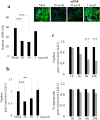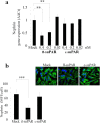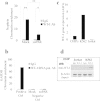Full-length soluble urokinase plasminogen activator receptor down-modulates nephrin expression in podocytes
- PMID: 26380915
- PMCID: PMC4585377
- DOI: 10.1038/srep13647
Full-length soluble urokinase plasminogen activator receptor down-modulates nephrin expression in podocytes
Abstract
Increased plasma level of soluble urokinase-type plasminogen activator receptor (suPAR) was associated recently with focal segmental glomerulosclerosis (FSGS). In addition, different clinical studies observed increased concentration of suPAR in various glomerular diseases and in other human pathologies with nephrotic syndromes such as HIV and Hantavirus infection, diabetes and cardiovascular disorders. Here, we show that suPAR induces nephrin down-modulation in human podocytes. This phenomenon is mediated only by full-length suPAR, is time-and dose-dependent and is associated with the suppression of Wilms' tumor 1 (WT-1) transcription factor expression. Moreover, an antagonist of αvβ3 integrin RGDfv blocked suPAR-induced suppression of nephrin. These in vitro data were confirmed in an in vivo uPAR knock out Plaur(-/-) mice model by demonstrating that the infusion of suPAR inhibits expression of nephrin and WT-1 in podocytes and induces proteinuria. This study unveiled that interaction of full-length suPAR with αvβ3 integrin expressed on podocytes results in down-modulation of nephrin that may affect kidney functionality in different human pathologies characterized by increased concentration of suPAR.
Figures






References
-
- Sidenius N., Sier C. F. & Blasi F. Shedding and cleavage of the urokinase receptor (uPAR): identification and characterisation of uPAR fragments in vitro and in vivo. FEBS Lett 475, 52–56 (2000). - PubMed
-
- Eden G., Archinti M., Furlan F., Murphy R. & Degryse B. The urokinase receptor interactome. Curr Pharm Des 17, 1874–1889 (2011). - PubMed
-
- Selleri C. et al. Involvement of the urokinase-type plasminogen activator receptor in hematopoietic stem cell mobilization. Blood 105, 2198–2205 (2005). - PubMed
-
- Montuori N. & Ragno P. Multiple activities of a multifaceted receptor: roles of cleaved and soluble uPAR. Front Biosci (Landmark Ed) 14, 2494–2503 (2009). - PubMed
Publication types
MeSH terms
Substances
LinkOut - more resources
Full Text Sources
Other Literature Sources

